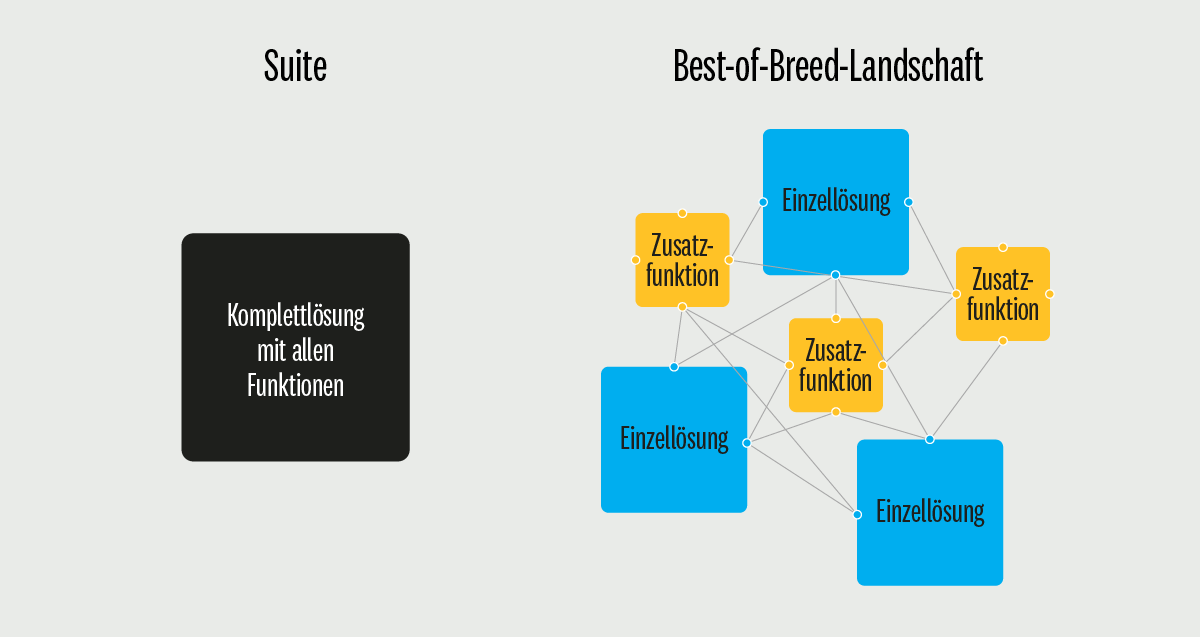- Jun 13, 2022
- 5 min
Best of breed vs. best of suite: the comparison
Magnolia in action
Take 12 minutes and a coffee break to discover how Magnolia can elevate your digital experience.
A radical restructuring of IT: a lot of companies are currently facing this. The digitalization push of recent years has pushed the old solutions to their limits. Companies now need an IT landscape that can meet the requirements of today and tomorrow.
How is this new IT landscape structured? Companies can pursue two fundamentally different approaches: Best of Breed or Best of Suite. In this article, we explain both, the advantages and disadvantages of each and help you decide.
Best of Breed vs. Best of Suite: What is it all about?
The comparison between Best of Breed and Best of Suite is about two software strategies, or two approaches to how a company selects the tools that make up its IT landscape: either combining several individual solutions or using one complete solution for everything.

Companies have to decide between best of breed and best of suite when setting up a digital experience platform (DXP), for example. You can find a comparison of the approaches using the example of a DXP here.
Let's analyze the two approaches and their advantages and disadvantages in detail.
Best of Breed: Specialized individual solutions
In the best-of-breed strategy, specialized individual solutions are combined and linked to form an overall platform. The idea behind this is to use the most suitable technology on the market for each process or task.
One software is defined as the leading core system and serves as the center for data exchange for the entire platform. Additional functions are added to the core system using separate solutions.
The best-of-breed approach is the basis for what is known as a composable enterprise: a modular, agile company.
By the way: The English term "Best of Breed" comes from animal breeding. Winners at livestock shows are awarded this title.
Advantages
What are the advantages of best-of-breed landscapes for companies?
All requirements can be covered perfectly
New solutions can be implemented and replaced relatively quickly and easily.
Companies can start with a lean IT platform
Solutions that are no longer required can be switched off and the costs saved.
The costs for individual solutions or tasks can be calculated transparently.
Companies are not so dependent on individual software providers.
Disadvantages
This is offset by a number of disadvantages or challenges:
The effort required to select and integrate the individual solutions is higher.
Individual solutions may not be fully compatible with each other or the interfaces may not yet be fully developed.
Separate license costs are incurred for each solution; these add up for large platforms with many individual solutions.
Several teams are required for operation and further development
Users must be trained separately for each solution.
Best of Suite: A complete solution for everything
When a company opts for the best-of-suite approach, it uses a complete or all-in-one solution that covers as many processes or tasks as possible. Microsoft Office 365 or Adobe Creative Cloud are popular examples of such suites. Such solutions can also be selectively supplemented with additional tools.
Advantages
What advantages does a software suite offer?
Suites are usually proven
Companies get all the tools they need in one go.
The components are coordinated
Users only need to be trained once for the complete solution.
There is only one contact person for the software.
A single team can take care of operations.
At this point, we have to make one reservation about the advantages: suites are not always one-size-fits-all solutions. Sometimes they consist of solutions that the manufacturers have bought in, integrated more or less well and now market as a package. The look and feel of the solutions in the suite can then differ.
Disadvantages
What are the disadvantages and challenges of the best-of-suite approach?
Companies become heavily and long-term dependent on a single provider. Changing software is associated with extremely high costs.
The further development of the suite can hardly be influenced. Companies have to make do with the standard functionality of the suite.
The introduction of a suite usually involves a lengthy IT project.
Companies have to buy the complete suite immediately; they cannot "start small". They also pay for functions that they do not use.
Suites offer fewer customization options; some providers also restrict the integration of other solutions (closed API).
What is suitable for whom?
Which approach is more suitable depends on a company's goals and digital strategy.
Companies are best off with Best of Suite if they want a standard solution that runs stably and in which they do not want to invest too many of their own resources. In return, they pay a higher price and forego flexibility.
Best of breed tends to be chosen by companies that have high requirements, want to develop in an agile way and want to be digital leaders. In return, they are prepared to invest more in their IT platform.
Both approaches can also be combined; in reality, a "soft" best-of-breed variant is often found: The core of the IT landscape is formed by a number of "larger" systems, such as solutions for headless CMS, headless e-commerce and CRM. These are supplemented with a range of technologies. Such a landscape is manageable and easier to operate, while remaining flexible and agile.
In addition, functions from other solutions - such as SEO or digital asset management - can be integrated into the CMS interface. Marketers then work largely in a central system with a uniform look and feel. This means that one of the biggest advantages of a suite can also be implemented in a best-of-breed platform.










